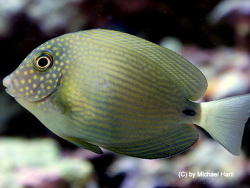Info
Commonly spread in the Indo-West Pacific Ocean, inhabits coastal fringing reefs and reef flats.May often be found schooling with other surgeonfish species grazing algae.Adults can easily be recognized by numerous light dots on the head and the yellow pectoral fins.
Information on adult size vary somewhat: According to Debelius and Kuiter it reaches up to 16 inches (40 cm) in length,fishbase.org, however, states the size of a grown-up white-freckled surgeonfish with only approx. 10 inches (25 cm).
In any case, it is not suitable for small tanks. General husbandry as other Acanthurus species.
The surgeonfishes (Acanthuridae), popular in marine aquaristics, are also called surgeonfishes.
They have horn-like blades in front of the tail root, they use as mainly defensive weapon (defense) against predators, but this sharp weapon is also used in fights among themselves.
Deep cuts in the body of opponents can cause permanent injuries, but often death occurs immediately.
If surgeonfishes are to be kept in pairs in an aquarium, fights between the fishes can be the order of the day, we could observe this several times with the very popular Hawaiian surgeonfish (Zebrasoma flavescens).
The scalpel-like blades can cause deep cuts, this is also true for the careless aquarist who wants to touch or catch the fish with unprotected hands.
Another problem can occur if one wants to catch surgeonfish with a landing net and transfer them after catching, the horn blade can easily get caught in the net.
Caution: Careless handling of the animal can cause deep cuts!
Information on adult size vary somewhat: According to Debelius and Kuiter it reaches up to 16 inches (40 cm) in length,fishbase.org, however, states the size of a grown-up white-freckled surgeonfish with only approx. 10 inches (25 cm).
In any case, it is not suitable for small tanks. General husbandry as other Acanthurus species.
The surgeonfishes (Acanthuridae), popular in marine aquaristics, are also called surgeonfishes.
They have horn-like blades in front of the tail root, they use as mainly defensive weapon (defense) against predators, but this sharp weapon is also used in fights among themselves.
Deep cuts in the body of opponents can cause permanent injuries, but often death occurs immediately.
If surgeonfishes are to be kept in pairs in an aquarium, fights between the fishes can be the order of the day, we could observe this several times with the very popular Hawaiian surgeonfish (Zebrasoma flavescens).
The scalpel-like blades can cause deep cuts, this is also true for the careless aquarist who wants to touch or catch the fish with unprotected hands.
Another problem can occur if one wants to catch surgeonfish with a landing net and transfer them after catching, the horn blade can easily get caught in the net.
Caution: Careless handling of the animal can cause deep cuts!







 De Jong Marinelife, Holland
De Jong Marinelife, Holland




















































